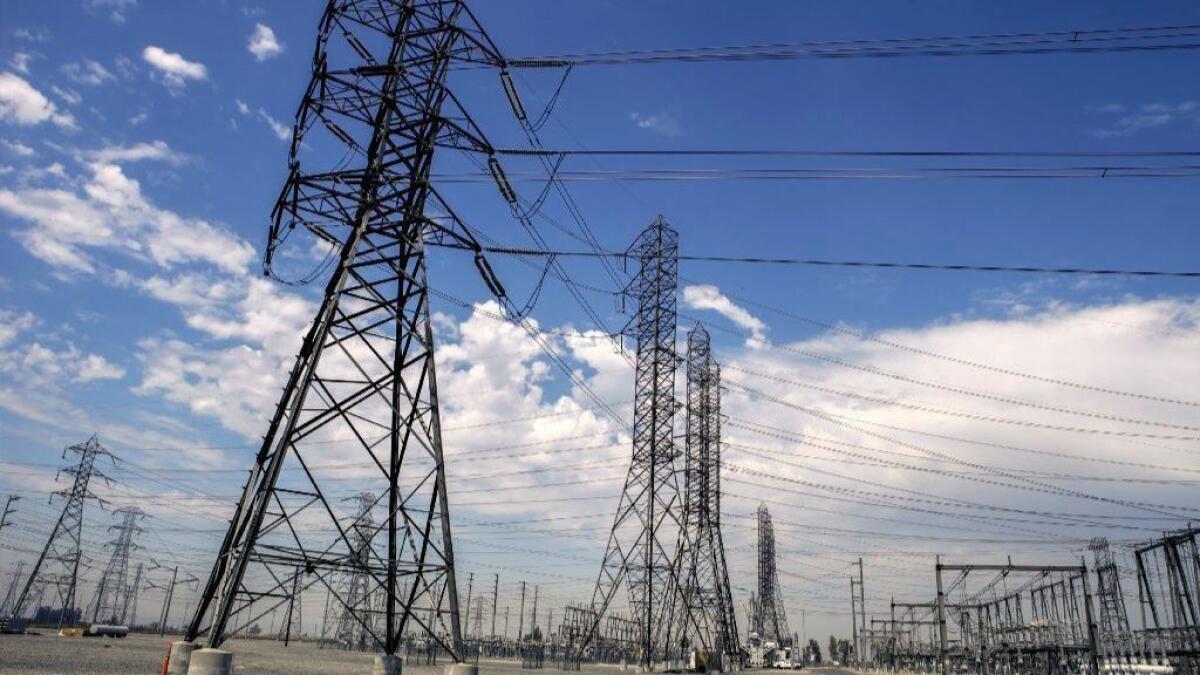What you need to know about Clean Power Alliance, SoCal’s newest electric company

Southern California Edison has been the region’s dominant electric utility for more than a century. But for nearly 1 million homes across the Southland, the days of Edison’s monopoly are ending.
Clean Power Alliance is becoming the default energy provider this month for residents of 29 cities, as well as unincorporated parts of Los Angeles and Ventura counties. The government-run power agency launched for a small group of customers last year and will continue its rollout in May, when it expands service to 100,000 businesses.
If Clean Power Alliance is your new power company, you should have received notices in the mail by now. But you probably still have plenty of questions.
Here’s everything you need to know about the switch, including what it means for your electricity rates and why Edison isn’t going away entirely.
How do I know if Clean Power Alliance will be my new energy provider?
If you live in one of these cities, you’ll be switched to Clean Power Alliance service by the end of February: Agoura Hills, Alhambra, Arcadia, Beverly Hills, Calabasas, Camarillo, Carson, Claremont, Culver City, Downey, Hawaiian Gardens, Hawthorne, Malibu, Manhattan Beach, Moorpark, Ojai, Oxnard, Paramount, Redondo Beach, Rolling Hills Estates, Santa Monica, Sierra Madre, Simi Valley, South Pasadena, Temple City, Thousand Oaks, Ventura, West Hollywood and Whittier.
The February switch also applies to residents of unincorporated Los Angeles and Ventura counties. Westlake Village residents are on track to start receiving service from Clean Power Alliance in 2020.
Residents of cities with their own municipal power departments, such as Los Angeles, Burbank and Glendale, will stick with their city-run energy provider.
Can I sign up for Clean Power Alliance if I’m an Edison customer living somewhere else?
No.
Why is this happening? Do I need to do anything?
You don’t need to do anything. Your electricity service will continue uninterrupted after you’re switched from Edison to Clean Power Alliance, which will happen automatically after your regularly scheduled meter reading in February.
This is happening because the 29 cities and two counties got together and created a community choice aggregator, or CCA. Forming a CCA allows local governments to decide what kinds of power to buy for their communities, how much to charge and what incentives to provide for going solar or reducing energy use.
California had 19 CCAs serving more than 8 million customers last year, but Clean Power Alliance will be the biggest one yet. Elsewhere in Southern California, local governments are making plans to form CCAs in Riverside County and San Diego, where Mayor Kevin Faulconer recently endorsed calls for community choice.
Am I going to pay more for electricity?
It depends what you want from Clean Power Alliance. The CCA offers three rate plans to its customers: One with a 36% renewable energy mix that the alliance says is 1% cheaper than Edison’s base rate, one with 50% renewables that’s on par with Edison, and one with 100% renewables that’s 9% more expensive than Edison.
Every city and county in Clean Power Alliance has chosen one of those plans as the default for its residents. Eight cities picked the cheapest option; nine cities, plus Ventura County, opted for the 100% renewables rate.
If you don’t like your local government’s choice, you can switch to another rate plan at any time. You can also opt out of Clean Power Alliance and return to Edison. Of the roughly 960,000 homes and businesses that will be eligible for Clean Power Alliance by the end of February, just 14,000, or less than 1.5%, have opted out.
So who’s setting my electricity rate now? And what will they do with my money?
Rates are set by Clean Power Alliance’s 31-member board of directors, with one representative from each city and county. The board is chaired by Diana Mahmud, a South Pasadena City Council member. Its monthly meetings are open to the public.
Clean Power Alliance has big plans for cleaning up the region’s energy supply, said Ted Bardacke, the alliance’s executive director and a former infrastructure director for L.A. Mayor Eric Garcetti.
Over time, that could mean incentives for customers to install electric water heaters or space heaters, reducing the need to burn natural gas in homes and other buildings. It could mean free or discounted electric vehicle chargers, or special electricity rates that encourage people to charge their EVs at home. It also could mean community battery installations that reduce the need for polluting, gas-fired “peaker” power plants.
“We’re very interested in projects that not only reduce greenhouse gas emissions but also reduce local air pollution, and that leads you to also improve public health,” Bardacke said.
Can I still put solar panels on my roof?
Yes. Clean Power Alliance offers a net metering rate plan for solar-powered homes and businesses just as Edison does, but with slightly more favorable terms.
Does community choice have any drawbacks?
So far, most CCAs seem to be living up to their promises of cleaner energy, lower rate options and local decision-making. But it’s yet to be seen how they’ll fare over the long term. Some renewable energy companies are worried the CCAs won’t be able to buy enough clean power over the next few years to meet the state’s climate change goals. The CCAs dispute that premise, saying they’re buying plenty of solar and wind energy.
Michael Picker, president of the California Public Utilities Commission, has also warned that the shift from monopoly utilities to more decentralized decision-making could have dangerous unintended consequences, such as a repeat of the state’s early-2000s energy crisis. The CCAs say that concern is hugely overblown.They point out that the state’s first community choice provider, Marin Clean Energy, launched in 2010, followed by Sonoma Clean Power in 2014 and Lancaster Choice Energy in 2015, and so far there have been no crises.
But 16 more CCAs have started serving customers in the last three years, and it’s hard to predict how things will shake out — especially as California’s energy sector is also reshaped by other forces, including a mandate of 100% clean power by 2045 and the bankruptcy filing of the state’s biggest utility, Pacific Gas & Electric.
Does community choice mean Edison is going away?
No. Edison will still be responsible for operating the poles and wires of the electric grid, and Clean Power Alliance customers will still pay the investor-owned utility for those services. Edison will still send out everyone’s bills too.
Clean Power Alliance customers will also see a new item on their bills: the “Power Charge Indifference Adjustment,” more commonly known as the exit fee. As the name suggests, it’s an additional monthly charge that CCA customers must pay Edison to cover the costs of long-term contracts signed by the utility years ago to provide electricity to all of its customers. State officials say it’s only fair for CCA customers to keep covering their share of those costs because Edison would otherwise have to increase rates for its remaining customers.
How utilities are striking back against community choice »
There’s an ongoing debate about how to calculate the exit fees, with CCAs arguing the investor-owned utilities are inflating the numbers. The Public Utilities Commission approved an increase in the exit fees last year, although the commission may continue to tweak that decision.
So that’s everything I’ll still be paying to Edison, right?
Not quite. For the next year, homes served by Clean Power Alliance will also pay an additional $100 million to Edison to help fill a hole in the company’s power budget. Edison said it spent about $815 million more than it expected on electricity in 2018, partly because of a summer heat wave. The utility asked the Public Utilities Commission for permission to charge some of those costs to homes leaving this month for Clean Power Alliance because Edison purchased the electricity on behalf of all its customers, including those now leaving.
The Public Utilities Commission approved that request in a 5-0 vote on Tuesday, over the objections of Clean Power Alliance. The community choice provider had said it would have to cut into its financial reserves to offer customers the rate savings it promised, while accounting for the additional $100 million they will now pay.
Cliff Rechtschaffen, a member of the Public Utilities Commission, said the additional charge will probably raise electricity prices for Edison and Clean Power Alliance customers by about 5% over the next year.







